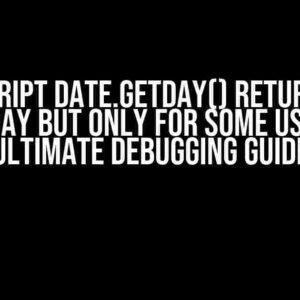Are you tired of staring at your scraper’s output, wondering why it’s not pulling the data you need? You’re not alone! As a seasoned web scraping enthusiast, I’ve been there, done that, and got the t-shirt. In this article, we’ll dive into the common reasons why your scraper might be failing to scrape the desired elements and provide you with actionable tips to get your scraper back on track.
Reason 1: Inadequate HTML Inspection
Before we start writing any code, it’s essential to inspect the HTML structure of the webpage we’re trying to scrape. Sounds simple, right? But you’d be surprised how often this step gets overlooked. A thorough HTML inspection can make all the difference between a successful scrape and a failed one.
Here’s what you need to do:
- Open the webpage in your favorite browser.
- Press F12 or right-click and select “Inspect” to open the browser’s developer tools.
- Switch to the Elements tab.
- Use the Elements tab’s search function (Ctrl + F) to find the HTML elements containing the data you want to scrape.
- Take note of the element’s tag name, class, id, and any other attributes that might be relevant.
<div class="product-info"> <h2>Product Title</h2> <p>Product Description</p> <span>$100.00</span> </div>
In this example, we’re interested in scraping the product title, description, and price. We’ve identified the HTML elements containing this data and taken note of their attributes.
Reason 2: Insufficient XPath or CSS Selectors
Now that we’ve inspected the HTML, it’s time to craft our XPath or CSS selectors. These selectors are used to target the specific elements we want to scrape. However, if they’re not specific enough or are poorly written, our scraper will fail to extract the desired data.
Here are some tips for writing effective XPath or CSS selectors:
- Be specific! Avoid using generic selectors like `//div` or `div *`. Instead, use a combination of tag names, classes, and ids to target the exact element.
- Use the browser’s developer tools to test your selectors. You can do this by executing them in the console or using the Elements tab’s “Elements” sidebar.
- Avoid using XPath’s `//` syntax, which can lead to performance issues. Instead, use a more efficient syntax like `/html/body/div[1]/h2`.
- When using CSS selectors, keep in mind that they’re subject to CSS specificity rules. This means that more specific selectors will take precedence over less specific ones.
// XPath example
/html/body/div[@class="product-info"]/h2
// CSS selector example
.product-info > h2
Reason 3: JavaScript-generated Content
Many modern webpages use JavaScript to generate content dynamically. This can make it challenging for our scraper to extract the desired data, as the content might not be present in the initial HTML response.
Here are a few strategies to overcome this obstacle:
- Use a headless browser like Puppeteer or Selenium, which can execute JavaScript and wait for the content to load.
- Employ a library like Scrapy’s Splash or PyPPETEER, which provides a JavaScript rendering service.
- Use a proxy service like ScrapingBee, which can render JavaScript and return the HTML response.
import puppeteer from 'puppeteer';
(async () => {
const browser = await puppeteer.launch();
const page = await browser.newPage();
await page.goto('https://example.com');
await page.waitForSelector('.product-info'); // wait for the content to load
const html = await page.content();
// extract the desired data from the HTML
await browser.close();
})();
Reason 4: Anti-Scraping Measures
Some websites employ anti-scraping measures to prevent bots from extracting their data. These measures can include:
- CAPTCHAs
- Rate limiting
- IP blocking
- Honeypot traps
To overcome these obstacles, you can try:
- Using a CAPTCHA-solving service like 2Captcha or Anti-Captcha.
- Implementing a rate limiter in your scraper to avoid hitting the website’s API too frequently.
- Rotating your IP address using a proxy service like ScrapingBee or by using a VPN.
- Adding a delay between requests to mimic human behavior.
Reason 5: Inadequate Error Handling
Even with a well-crafted scraper, errors can still occur. It’s essential to implement robust error handling to ensure that your scraper can recover from unexpected issues.
Here are some best practices for error handling:
- Use try-catch blocks to capture and handle exceptions.
- Implement a retry mechanism to handle temporary errors like network failures.
- Log errors and exceptions to identify patterns and debug issues.
- Use a scraper framework like Scrapy, which provides built-in error handling and retry mechanisms.
try {
// scrape the data
} catch (error) {
console.error(error);
// retry the request or log the error for later analysis
}
Reason 6: Poor Data Cleanup and Processing
After extracting the data, it’s essential to clean and process it to make it usable. This step is often overlooked, leading to poor data quality and inconsistencies.
Here are some tips for data cleanup and processing:
- Use regular expressions to extract specific patterns from the data.
- Employ a library like BeautifulSoup or Cheerio to parse and clean HTML content.
- Use a data validation library like Joi or Schema to ensure data consistency and validity.
- Perform data transformation and normalization to make it compatible with your desired output format.
| Original Data | Cleaned Data |
|---|---|
| <h2>Product Title</h2> | Product Title |
| <p>Product Description</p> | Product Description |
| <span>$100.00</span> | 100.00 |
By following these guidelines and avoiding common pitfalls, you’ll be well on your way to building a robust and efficient web scraper that can extract the desired elements with ease.
Remember, web scraping is an art that requires patience, persistence, and practice. Don’t be discouraged if your scraper doesn’t work as expected initially. Debug, refine, and iterate – and you’ll eventually master the craft of web scraping!
Got any questions or need help with your web scraping project? Feel free to ask in the comments below!
Conclusion
In this article, we’ve explored the common reasons why your scraper might not be scraping the desired elements. By inspecting the HTML structure, crafting effective XPath or CSS selectors, handling JavaScript-generated content, overcoming anti-scraping measures, implementing robust error handling, and performing proper data cleanup and processing, you’ll be able to build a web scraper that can extract the data you need with ease.
Happy scraping!
Frequently Asked Question
Getting stuck with a scraper that won’t scrape the desired elements? Don’t worry, you’re not alone! Here are some common pitfalls and solutions to get you back on track.
Why isn’t my scraper picking up the HTML elements I need?
Check if the elements you’re trying to scrape are loaded dynamically by JavaScript. If they are, your scraper might not be waiting long enough for the JavaScript to execute. Try adding a delay or using a headless browser to ensure the page is fully loaded before scraping.
I’m using the correct CSS selectors, but my scraper is still not finding the elements. What’s going on?
Double-check if the website is using anti-scraping measures like bot detection or rate limiting. These can prevent your scraper from accessing the content. You might need to add user-agent rotation, delay between requests, or use a proxy to avoid being blocked.
My scraper is returning a 403 Forbidden error. How do I fix this?
The website might be blocking your scraper’s IP or user-agent. Try rotating your user-agent to mimic a real browser or use a proxy to change your IP. You can also check if the website has a robots.txt file that specifies crawling rules and adjust your scraper accordingly.
I’ve checked everything, but my scraper is still not scraping the data I need. What’s next?
Take a closer look at the HTML structure of the page. Sometimes, elements can be nested within iframes or have tricky naming conventions. Use the browser’s developer tools to inspect the elements and adjust your CSS selectors accordingly. You can also try using a visual scraper or a scraping framework like Scrapy to simplify the process.
I’m scraping a website with a lot of Ajax content. How do I handle this?
Ajax content can be challenging to scrape. Try using a headless browser like Selenium or Puppeteer to load the page and wait for the Ajax requests to complete. You can also use a scraping framework like Scrapy with a built-in Ajax handling module to simplify the process.



